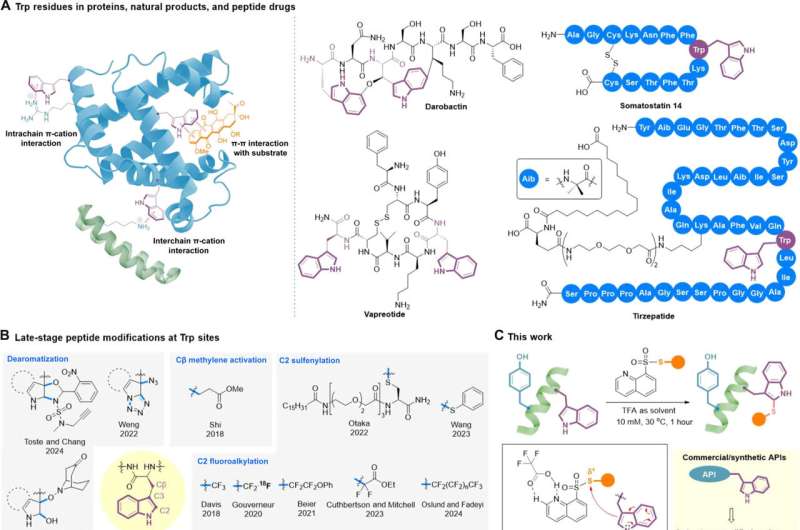This article has been reviewed according to Science X's editorial process and policies. Editors have highlighted the following attributes while ensuring the content's credibility:
fact-checked
peer-reviewed publication
trusted source
proofread
Chemists develop clickable tryptophan modification strategy for late-stage diversification of native peptides

Peptides are gradually emerging as middle-sized therapeutic agents for addressing unmet medical needs. Compared to small-molecule drugs, peptides can target complex biological processes more precisely while being generally less complex and more cost-effective than large biological drugs such as antibodies.
More than 100 FDA-approved peptide drugs have been on the market since the first peptide hormone insulin was developed in 1923, among which about 40 drugs for treating a wide range of diseases (e.g., cancer, cardiovascular, and metabolic diseases) contain at least one tryptophan (Trp) residue, which is a key amino acid.
Modifying Trp residues in peptide molecules can help regulate the drug-target interactions and improve drug stability, bioavailability, and pharmacokinetics properties. However, enabling transformations on these functionally dense molecules requires a high level of selectivity, such as chemoselectivity, regioselectivity, and stereoselectivity.
Additionally, peptides' nucleophilic functionalities make them sensitive to redox conditions, further complicating modifications. The limited solvents for dissolving unprotected peptides also pose challenges. As a result, developing site-specific late-stage peptide modifications is a daunting task.
Recently, a team led by Professor Xuechen LI from the Department of Chemistry of The University of Hong Kong (HKU) developed a clickable tryptophan modification strategy. This strategy allows for the easy modification of a specific part of a peptide molecule even at the late-stage of the drug development process. This late-stage diversification technique allows them to fine-tune peptides even after the core structure is established.
Their findings have recently been published in Science Advances.
This approach involves a late-stage catalyst-free C2-sulfenylation reaction using S-modified quinoline-containing thiosulfonate reagents. Through this method, the researchers efficiently install a variety of functional groups onto the tryptophan (Trp) residues within the native peptide structures. The introduced groups include trifluoromethylthio, difluoromethylthio, (ethoxycarbonyl) difluoromethylthio, alkylthio and arylthiol.
In this transformation, trifluoroacetic acid (TFA) was used as the optimal solvent and played an important role in the activation of the reagents via hydrogen bond interaction. Moreover, the super dissolving capability of TFA for hydrophobic and aggregation-prone peptides ensures the applicability of this method to challenging molecules like lipopeptides and self-assembling peptides, even at relatively high concentrations.
This method was successfully applied to the late-stage modification of several on-market peptide drugs, such as somatostatin, octreotide, lanreotide, setmelanotide, daptomycin and semaglutide, as well as the bioactive glycopeptide hAdn-WM6877, showcasing the applicability of this method to the diversity-oriented modification of peptide-based active pharmaceutical ingredients.
Professor Li's team found that the bioactivity and serum stability of modified melittin analogs were improved, which demonstrated the great potential of this method in drug development. Because Trp widely exists in RiPP natural products like darobactin and chloropeptin I, and drug leads screened from phage display and mRNA display, this method will also be useful for natural product late-stage diversification for making molecular libraries and functional probes.
The team also believes this single-step clickable late-stage Trp modification method will provide a robust platform for generating structural analogs in a cost-efficient manner, satisfying the demand for optimizing drug activities and pharmacokinetic properties, and will become a precious tool for medicinal chemists, peptide chemists, and chemical biologists.
More information: Yisa Xiao et al, Clickable tryptophan modification for late-stage diversification of native peptides, Science Advances (2024). DOI: 10.1126/sciadv.adp9958
Journal information: Science Advances
Provided by The University of Hong Kong





















